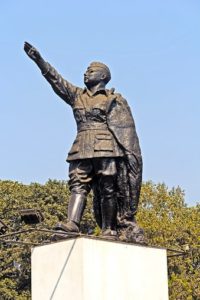 Introduction :
Introduction :
This is the essay I wrote for the essay competition organized by the High Commission of India in 2021. The assigned topic was “Netaji in Singapore”. This essay helped me score 1st place in the senior category.
More information published by the High Commission of India Singapore on their facebook post.

Coming out of my reverie, I made my way towards my history classroom and plopped down on the chair after greeting my teacher.
“Do you remember our last field trip to Esplanade Park?” she put out her odd question. After hearing an affirmation and confused murmurs from the class, she laughed and continued “How many of you found time to stop playing and see the INA monument?”
No one raised their hands.
“I thought so. This is a monument built in the honor of Subhas Chandra Bose and INA. Today’s lesson will be about his work in Singapore.”
Huh? How will he fight for India outside India? I am starting to think that the teacher might be ill today.
“Netaji Bose believed that freedom was a birthright, and one should not negotiate with the same people who ruthlessly snatched it from them. He believed in military action.
“In 1940, when Netaji was imprisoned by the British under the defense of India Rules, he went on a hunger strike. To improve his deteriorating health, the British put him under house arrest in Kolkata instead. However, this strike was a plan fashioned by Netaji so that he could go home from where he slipped away to Germany through a route in Afghanistan.”
“Why did he go to Germany?” a curious Vikas questioned the teacher.
“He had understood that India was in dire need of an army to fight for independence, but such an army could not be formed in India due to the strict surveillance of the British on all the prominent leaders. He found out that there were not only Indian patriots overseas but also other countries who were dead set on destroying British Rule. He wished to train an army outside India with their assistance to eradicate the British.”
“Ma’am but how will the soldiers trained on foreign soil be able to feel the same patriotism in them as the ones in India?” Priya asked.
“That was the thing that made Mr. Bose such as extraordinary revolutionist. He was revered by the masses and people had great trust in him. Netaji was also an eloquent orator, he could easily make people see his side of the story, and this skill of his rejuvenated the feeling of nationalism in Indians outside the country.
“Anyway, in the 1940s Singapore was a part of Malaya, or Malaysia as we call it today. It was under the patronage of Japan. Netaji traveled from Germany to various places including Malaya. He arrived at Kallang on 2nd July 1943 when Rash Bihari Bose invited him.
“Mohan Singh, an ex-Indian officer in the British army had sowed the seeds of an Indian Army with the help of the Japanese leaders. The Indian Prisoners of War were sent to him, under his guidance they were inducted into the INA or Indian National Army. With the fall of Singapore under the Japanese forces, around 45,000 new recruits were sent to the INA.
“After Netaji’s arrival in Singapore, he took over the reins of the Indian National Army and inculcated a lucid goal in the minds of his soldiers-to liberate India from the clutches of the British. He set up the Provisional Government of Free India on 21st October 1943 at Cathay Cinema Hall. Through this, he officially declared war on the British and their ally US.”
“Ma’am, Ravi is not taking notes.” Shankar, the complain-box of the class whined.
“Both of you please focus on your own notes,” the teacher chided and then continued “The first territory acquired by the Provisional Government was when Japan allocated the Andaman and Nicobar Islands to the INA.
“Bose encouraged his soldiers to crusade for India with the battle cries ‘Give me blood and I will give you freedom’ and ‘Let us go to Delhi.’ Under Netaji’s supervision, the INA managed to capture Moirang in Manipur but unfortunately failed to capture any other regions. And so, Netaji returned to Singapore where on 12th August 1945 he received the harrowing news of the fall of the Japanese in World War II. So, the INA was dissolved. However, before Netaji could find another leader to support the army he was the victim of a fatal plane crash.”
“So, the army failed?” Priya asked.
“Well…yes.”
The bell rang and we all rushed out, but today’s class replayed in my mind.
I disagreed with the teacher on today’s history lesson about Netaji’s work in Singapore.
INA set an inspiring example of patriotism and revealed the loyalty of Indians abroad. People also overlooked the blatant fact that this campaign was the first of the many threads that linked India to Singapore. Now as the years have flown by this thread is accompanied by many others, forming an ethereal tapestry of national friendship and love between the two countries. Netaji might not have been able to achieve his aim in Singapore, but he did manage to pull off quite an incentivizing feat that is commended and respected by people.

Click Here to send your feedback.

